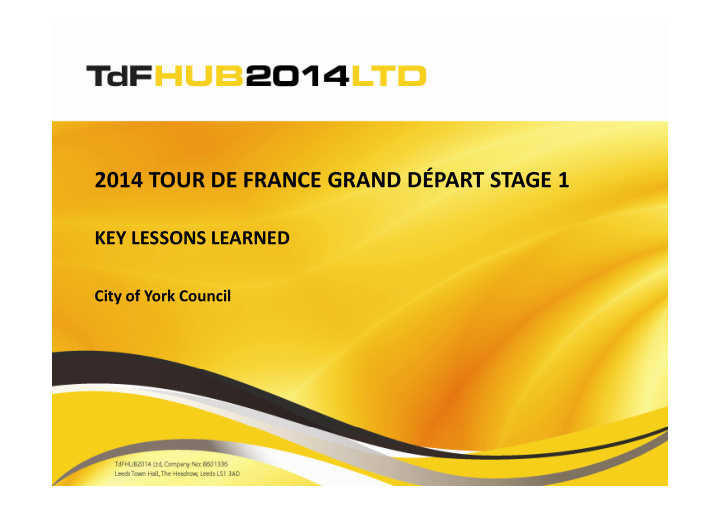



2014 TOUR DE FRANCE GRAND DÉPART STAGE 1 KEY LESSONS LEARNED City of York Council
Planning Phase What Went Well and Why? • Transport and traffic management – transport partners were involved at an early stage; early changes to the route reduced the impact on traffic flow; there were regular regional and local meetings. • Working together and relationships with other local authorities. • Risk management and contingency planning for the event in York was thorough. • Selection of the route – this showed off the city and it’s historic buildings very well. • • External staff were brought in with the required expertise in event management. External staff were brought in with the required expertise in event management. • In the weeks running up to the event, the TDF Project team were all located in one room in West Offices which enabled their communicating and working together effectively. • Positive comms in the local press. • Staff enthusiasm and willingness to go above and beyond what is normally expected of them. • Opportunity for key staff to go to France to see the Tour the year before – this greatly improved understanding of the event.
Planning Phase What Could Have Been Improved and How? • An earlier appreciation of the scale of the event and the amount of staff time required - we should have brought our TDF team together earlier and brought in the necessary external expertise earlier. • Ensuring that our internal operational areas pass all the relevant information to the CYC comms team promptly (and that the info is accurate). • Re central procurement - having the flexibility to opt out where appropriate and choose local companies that could provide a better service and price. choose local companies that could provide a better service and price. • TDF Hub did not provide templates for plans. If a template had been provided it would have encouraged a consistent approach. • Spectator Hub Capacity/Planning • The delays in getting the sign-off for the regional branding and logo had a knock- on effects on timescales. • Cross-party political support for commercial activity. • Earlier plan for commercial activity to create markets/customer base.
Delivery Phase What Went Well and Why? • Crowd management – a lot of detailed planning went into this in York. • Yorks back-up plan for radio communication worked effectively (RAYNET and council radios, supported by NYP Airwave system). • Traffic management and comms around travel were good (leaflet, websites, twitter). • Public perception, enthusiasm and enjoyment of the day. • • Visual aspects around the city e.g. community banners project on the city walls Visual aspects around the city e.g. community banners project on the city walls • The start arrangements at the racecourse went very smoothly. • Sports activities at the Hubs provided by CYC Sport & Active Leisure team received very good feedback. • Relationships with multi-agency partners • Experience of running a control room for a large event will hopefully be useful in the future.
Delivery Phase What Could Have Been Improved and How? • Having a radio system that works – this should have been tested much earlier. • Big screens to be in place and tested in advance of the event. • Clearer communication of the process for re-opening roads after the event to provide clarity for the public and for the barrier company. • More consistent quality of stewarding – better briefed (did not know local area or route), some had worked double shifts and were very tired. • • Having all the key CYC staff in one control room on the day (in West Offices there Having all the key CYC staff in one control room on the day (in West Offices there were two control rooms, as neither room was big enough for everyone). • The command structure proposed by TDF Hub seemed over complicated and confusing. • Requests for information from TDF Hub during the event were significant and did not always seem relevant.
Recommend
More recommend